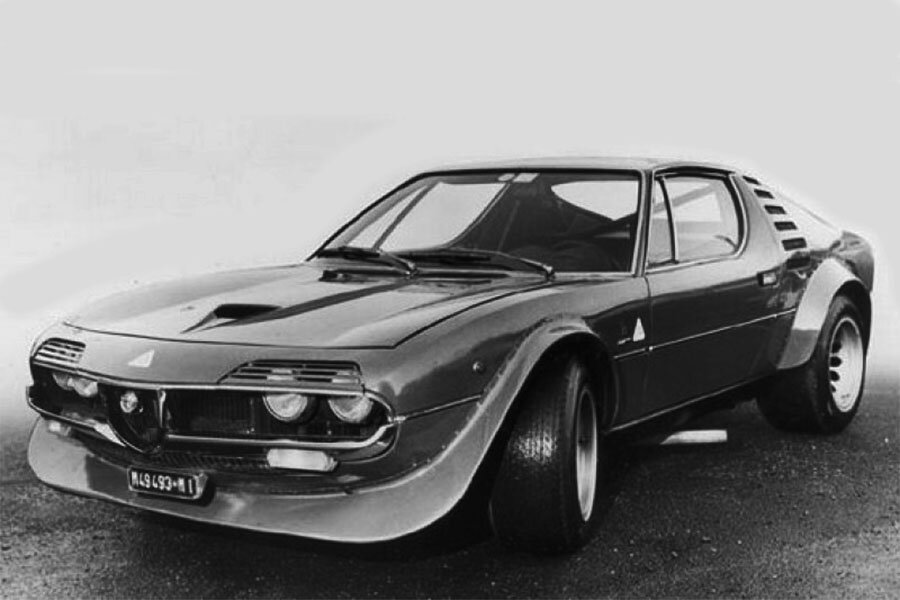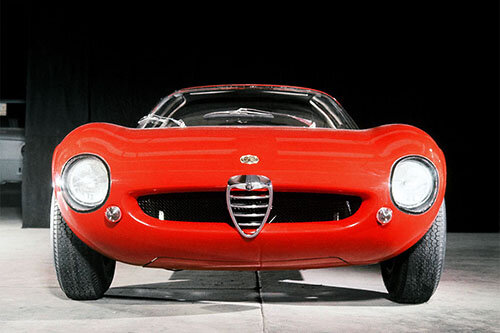Guide: Alfa Romeo Montreal Gr.4
Background
For much of 1972, Alfa Romeo’s motor racing division, Autodelta, was hard at work developing a new Flat 12 engine for use in the long-running Tipo 33 line of three-litre Group 6 Prototypes.
The Carlo Chiti-designed Flat 12 was a major undertaking for Autodelta; it was their first scratch built engine since the V8 power unit that arrived back in 1967.
In addition to the Flat 12 programme, Autodelta had received a commission for a Montreal racing car. The order came from Bob Cozza who was being bankrolled by Alfa Romeo USA to the tune of $100,000.
Cozza owned Bobcor, an Alfa Romeo dealership and racing team near Buffalo, New York. Bobcor was also the Autodelta representative for the USA and, since 1968, had achieved great success racing Alfa Romeo GTAs in the Trans-Am series.
Cozza thought the Montreal had great potential as a racing car for the burgeoning IMSA championship. Autodelta boss Chiti gladly accepted the commission and told Cozza he would have a car ready for the 1973 season.
In November 1972, Chiti called Cozza and told him to come to Italy as they had nearly finished the Montreal. Unfortunately, when Cozza arrived, he was disappointed to find the car had not been built to IMSA specification but for FIA Group 4 racing instead.
Cozza was extremely unhappy with the situation and informed Chiti he would be back in January 1973 with one of his race mechanics to start building an IMSA car from scratch.
As for the nearly completed Group 4 car, Autodelta applied the finishing touches and spent a brief period promoting it as a potential customer racing model.
The Montreal qualified for Group 4 on account of meeting the 500 car production requirement in a twelve month period. It had been homologated as a matter of course on October 31st 1971.
Chassis
For the Group 4 racer, a standard Montreal was plucked from the production line (chassis AR1425230). It was then transformed into a fully fledged competition variant.
The unitary steel bodyshell was kitted out with a roll cage and stripped of all superfluous weight.
The double wishbone front suspension was retained while, at the back, Autodelta installed the sliding block system from the Giulia GTA which was adapted to locate the live trailing arm axle.
Adjustable dampers were fitted all round along with anti-roll bars at either end.
Ventilated disc brakes from the production car were installed while the massive 14 and 15-inch wheels were imported from the Tipo 33.
Engine & Gearbox
The standard Montreal used an all-alloy 90° V8 with dual overhead camshafts and dry-sump lubrication. Compression was 9.0:1, the complex indirect mechanical fuel-injection was supplied by SPICA and electronic ignition came from Bosch.
In this configuration, the engine produced 200bhp at 6500rpm and 173lb-ft at 4750rpm.
The Group 4 motor was one of several hybrid engines created by Autodelta that came in somewhere between the standard Montreal unit and that of the 1972 Tipo 33/TT/3 Group 6 Prototype.
As per the Group 6 engine, displacement was 2998cc compared to 2593cc for the road-going Montreal. This was achieved by increasing the bore diameter from 80mm to 86mm while stroke stayed at 64.4mm.
The Group 4 engine also came with a single-plane forged steel crankshaft, lightened flywheel and uprated pistons. Inlet throttles were of the slide type used by the Tipo 33/2.
Unlike the Tipo 33/TT/3, the Group 4 Montreal engine used single instead of twin plug ignition and two instead of four valve cylinder heads. Likewise, the SPICA fuel-injection was retained whereas a Lucas system was employed in the Tipo 33.
The compression ratio was increased from the 11.0:1 used in Group 6 engines to 11.25:1.
Autodelta quoted a peak output of 370bhp at 9000rpm which compared favourably to the 33/TT/3’s 440bhp at 9800rpm.
Transmission was via a ZF five-speed manual gearbox with reinforced clutch and limited-slip differential.
Bodywork
Group 4 regulations permitted a number of changes to a car’s standard bodywork. In the Montreal’s case, fibreglass wheelarch extensions were riveted in place to cover the wider Tipo 33 wheels. The front wheelarch extensions were integrated with a massive chin spoiler.
The front lid and rear hatch were held in place with pin fasteners. The NACA duct which had been a purely cosmetic addition on the production Montreal was enlarged and made functional.
Interior
Inside, the standard Montreal’s dash architecture was retained. The seats were ditched in favour of a single bucket with competition harness.
Weight / Performance
Compared to other Group 4 cars like the Porsche 911 2.8 Carrera RSR and De Tomaso Pantera Gr.4, the Montreal was overweight and under-braked. It tipped the scales at 1200kg and most likely had a top speed in the region of 165mph.
Completion
The newly completed car was tested at Alfa Romeo’s Balocco proving ground by Teodoro Zeccoli and Carlo Facetti.
Its public debut followed at the London Racing Car Show in January 1973. Afterwards, the handsome bright green machine was displayed at Alfa Romeo GB’s Edgware Road showroom. However, there were no takers in the UK and, a few weeks later, the Group 4 Montreal was returned to Autodelta and prepared for its first competition outing.
1973 Spa 1000km
It was taken along to the Spa 1000km World Sportscar Championship race on May 6th. This event was chosen as Autodelta were attending with the brand new Flat 12 powered Alfa Romeo Tipo 33/TT/12 which was entered for Rolf Stommelen and Andrea de Adamich.
Unfortunately, the 33/TT/12 failed to start after de Adamich span exiting the fast Stavelot right hander and went backwards into the armco. Although the car had already set sixth quickest practice time, its chassis was sufficiently damaged that starting the race was out of the question.
The Group 4 Montreal attended the Spa race under a Dino Pizzinato entry so as not to attract too much attention. Pizzinato was an Italian privateer who had raced Alfa Romeos at Spa since 1966. He was partnered in chassis AR1425230 by fellow amateur Nicolas Koob of Luxembourg but they failed to qualify.
Autodelta packed up early and headed back to Milan.
Shortly afterwards, AR1425230 was sold to Dieter Gleich, the Alfa Romeo distributor for Germany.
1973 Nurburgring 1000km
Gleich entered the Montreal under the Alfa Romeo Deutschland banner for the Nurburgring 1000km World Sportscar Championship race on May 27th.
He was co-driven by fellow countryman, Dieter Weizinger, but problems in practice meant the engine had to be changed. This was done by the Autodelta mechanics who were in attendance with a brace of the new Tipo 33/TT/12s.
Gleich and Weizinger qualified 44th out of 59 cars in practice but their race was cut short by more engine trouble.
Subsequent History
Later in 1973, Gleich ran the Montreal at the European GT Championship race at Hockenheim (DNF) and then picked up a third place finish in a minor non-championship race at Zolder.
Gleich then sold AR1425230 to Hamburg Alfa Romeo dealer, Hans Stahlberg.
Stahlberg had the car repainted white and raced it a couple of times without success before it was retired for good.
Text copyright: Supercar Nostalgia
Photo copyright: Alfa Romeo - https://www.alfaromeo.com


































